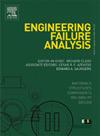Towards the classification and numerical prediction of fracture patterns in float glass using peridynamics
IF 5.7
2区 工程技术
Q1 ENGINEERING, MECHANICAL
引用次数: 0
Abstract
The strength of float glass is influenced by surface flaws introduced during processing and transportation, leading to varied fracture patterns under identical loading conditions. While previous studies use fracture mechanics to predict damage initiation based on flaw distribution, a systematic analysis of fracture patterns remains lacking. This study classifies fracture patterns from co-axial ring bending tests based on damage initiation type and location. Additionally, peridynamic theory is employed to model damage evolution using three approaches: (1) a quasi-homogeneous plate with an average critical bond stretch, (2) a plate with initial imperfections at different surface locations, and (3) a plate with a weaker skin layer. The peridynamic simulations closely replicate experimental fracture patterns in float glass, both with and without initial imperfections. While imperfection location significantly influences fracture patterns, its effect on strength is minimal. A weaker plate skin layer with decreased strength leads to a finer crack distribution.
浮法玻璃断裂模式的周动力学分类与数值预测
浮法玻璃的强度受加工和运输过程中引入的表面缺陷的影响,在相同的载荷条件下,浮法玻璃的断裂模式会发生变化。虽然以往的研究利用断裂力学来预测基于裂纹分布的损伤起裂,但缺乏对断裂模式的系统分析。本文根据损伤起裂类型和起裂位置对同轴环弯曲试验的断裂模式进行了分类。此外,采用周动力学理论,采用三种方法模拟损伤演化:(1)具有平均临界粘结拉伸的准均匀板,(2)在不同表面位置具有初始缺陷的板,以及(3)具有较弱蒙皮层的板。在浮法玻璃中,无论是有还是没有初始缺陷,动态模拟都能很好地复制实验断裂模式。虽然缺陷位置显著影响断裂模式,但对强度的影响很小。薄板蒙皮层越弱,强度越低,裂纹分布越细。
本文章由计算机程序翻译,如有差异,请以英文原文为准。
求助全文
约1分钟内获得全文
求助全文
来源期刊

Engineering Failure Analysis
工程技术-材料科学:表征与测试
CiteScore
7.70
自引率
20.00%
发文量
956
审稿时长
47 days
期刊介绍:
Engineering Failure Analysis publishes research papers describing the analysis of engineering failures and related studies.
Papers relating to the structure, properties and behaviour of engineering materials are encouraged, particularly those which also involve the detailed application of materials parameters to problems in engineering structures, components and design. In addition to the area of materials engineering, the interacting fields of mechanical, manufacturing, aeronautical, civil, chemical, corrosion and design engineering are considered relevant. Activity should be directed at analysing engineering failures and carrying out research to help reduce the incidences of failures and to extend the operating horizons of engineering materials.
Emphasis is placed on the mechanical properties of materials and their behaviour when influenced by structure, process and environment. Metallic, polymeric, ceramic and natural materials are all included and the application of these materials to real engineering situations should be emphasised. The use of a case-study based approach is also encouraged.
Engineering Failure Analysis provides essential reference material and critical feedback into the design process thereby contributing to the prevention of engineering failures in the future. All submissions will be subject to peer review from leading experts in the field.
 求助内容:
求助内容: 应助结果提醒方式:
应助结果提醒方式:


